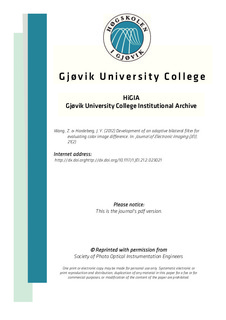Development of an adaptive bilateral filter for evaluating color image difference
Journal article, Peer reviewed
Permanent lenke
http://hdl.handle.net/11250/142540Utgivelsesdato
2012Metadata
Vis full innførselSamlinger
Originalversjon
Wang, Z. & Hardeberg, J. Y. (2012) Development of an adaptive bilateral filter for evaluating color image difference. In: Journal of Electronic Imaging (JEI), 21(2).Sammendrag
patial filtering, which aims to mimic the contrast sensitivity function (CSF) of the human visual system (HVS), has previously been combined with color difference formulae for measuring color image reproduction errors. These spatial filters attenuate imperceptible information in images, unfortunately including high frequency edges, which are believed to be crucial in the process of scene analysis by the HVS. The adaptive bilateral filter represents a novel approach, which avoids the undesirable loss of edge information introduced by CSF-based filtering. The bilateral filter employs two Gaussian smoothing filters in different domains, i.e., spatial domain and intensity domain. We propose a method to decide the parameters, which are designed to be adaptive to the corresponding viewing conditions, and the quantity and homogeneity of information contained in an image. Experiments and discussions are given to support the proposal. A series of perceptual experiments were conducted to evaluate the performance of our approach. The experimental sample images were reproduced with variations in six image attributes: lightness, chroma, hue, compression, noise, and sharpness/blurriness. The Pearson’s correlation values between the model-predicted image difference and the observed difference were employed to evaluate the performance, and compare it with that of spatial CIELAB and image appearance model.
Beskrivelse
This is the copy of journal's version originally published in Journal of Electronic Imaging: http://dx.doi.org/10.1117/1.JEI.21.2.023021. Reprinted with permission of SPIE.
